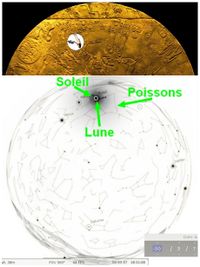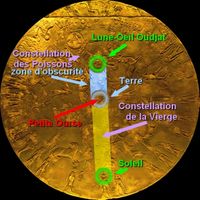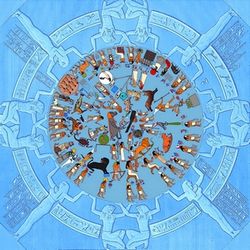دائرة بروج دندرة
26°8′30″N 32°40′13″E / 26.14167°N 32.67028°E
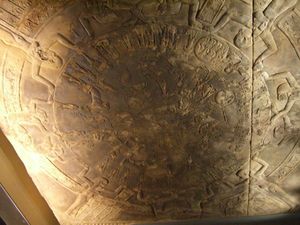
دئرة بروج دندرة Dendera zodiac، هي المنحوتة هي نقش بارز واسع الشهرة في معبد من أواخر العصر اليوناني-الروماني، وتضم صوراً من برجي الثور والميزان. وقد قام الفرنسيين برسم اسكتش لها أثناء الحملة الفرنسية على مصر. وفي 1820 انتُزعت من السقف وهي الآن في متحف اللوڤر. تخمين شامپليون بأنها بطلمية ثبت صحته والآن يُرجـِع علماء المصريات تاريخها إلى القرن الأول ق.م.[1]
ترجع أهميته لما كان في أحد الأروقة المضافة إليه خريطة فلكية نقشت فيها السماء وصور البروج. ولا يوجد في الوقت الحاضر من هذة الخريطة سوى نسخة (منقولة) إذ نقلت الخريطة الاصلية الى متحف اللوفر بباريس في فرنسا.
تواريخ الكسوف
سيلڤي كوڤي من مركز أبحاث المصريات المدعومة بحاسوب في جامعة أوترخت و إريك أوبورگ حددوا تاريخها بأنه 50 ق.م. عبر اختبار المواقع النسبية لخمسة أجرام سماوية معروفة للمصريين القدماء، فكان التشكيل الذي يحدث مرة كل ألف سنة، وتعريفه للكسوف والخسوف.[2]
الكسوف الشمسي يبين تاريخ 7 مارس 51 ق.م.: وتمثله دائرة تحتوي الإلهة إيزيس ممسكة رباح (بابون) (الإله تحوت) من ذيله.
الخسوف القمري يبين تاريخ 25 سبتمبر 52 ق.م.: تمثله عين حورس محبوسة داخل دائرة.
الوصف
The zodiac is a planisphere or map of the stars on a plane projection, showing the 12 constellations of the zodiacal band forming 36 decans of ten days each, and the planets. These decans are groups of first-magnitude stars. These were used in the ancient Egyptian calendar, which was based on lunar cycles of around 30 days and on the heliacal rising of the star Sothis (Sirius).
Its representation of the zodiac in circular form is unique in ancient Egyptian art.[بحاجة لمصدر] More typical are the rectangular zodiacs which decorate the same temple's pronaos.
The celestial arch is represented by a disc held up by four pillars of the sky in the form of women, between which are inserted falcon-headed spirits. On the first ring 36 spirits symbolize the 360 days of the Egyptian year.
On an inner circle, one finds constellations, showing the signs of the zodiac. Some of these are represented in the same Greco-Roman iconographic forms as their familiar counterparts (e.g. the Ram, Taurus, Scorpio, and Capricorn, albeit most in odd orientations in comparison to the conventions of ancient Greece[3] and later Arabic-Western developments), whilst others are shown in a more Egyptian form: Aquarius is represented as the flood god Hapy, holding two vases which gush water.[بحاجة لمصدر] Rogers noted the similarities of unfamiliar iconology with the three surviving tablets of a "Seleucid zodiac" and both relating to kudurru, "boundary-stone" representations: in short, Rogers sees the Dendera zodiac as "a complete copy of the Mesopotamian zodiac".[4]
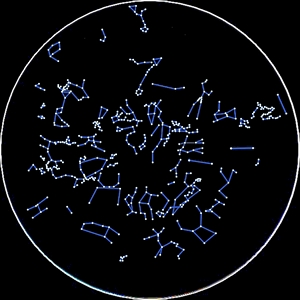
التاريخ
During the Napoleonic campaign in Egypt, Vivant Denon drew the circular zodiac, the more widely known one, and the rectangular zodiacs. In 1802, after the Napoleonic expedition, Denon published engravings of the temple ceiling in his Voyage dans la Basse et la Haute Egypte.[5] These elicited a controversy as to the age of the zodiac representation, ranging from tens of thousands to a thousand years to a few hundred, and whether the zodiac was a planisphere or an astrological chart.[6] Sébastien Louis Saulnier, an antique dealer, commissioned Claude Lelorrain to remove the circular zodiac with saws, jacks, scissors and gunpowder.[7] The zodiac ceiling was moved in 1821 to Restoration Paris and, by 1822, was installed by Louis XVIII in the Royal Library (later called the National Library of France). In 1922, the zodiac moved from there to the Louvre.
"قضية دندرة"
The controversy around the zodiac, called the "Dendera Affair", involved people of the likes of Joseph Fourier (who estimated that the age was 2500 BC).[8] Champollion, among others, believed that it was a religious zodiac. Champollion placed the zodiac in fourth century AD.[9] Georges Cuvier placed the date 123 AD to 147 AD.[10] His discussion of the dating question is an interesting summary of the reasoning as he understood it in the 1820s.
الهوامش والمصادر
- Sébastien Louis Saulnier, Claude Lelorrain, Notice sur le voyage de M. Lelorrain en Égypte في كتب گوگل, Éditions Sétier, 1822.
- Nicolas B. Halma, Examen et explication du zodiaque de Denderah comparé au globe céleste antique d'Alexandrie, Éditions Merlin, 1822.
- J. Chabert, L. D. Ferlus, Mahmoud Saba, Explication du zodiaque de Denderah (Tentyris), Éditions Guiraudet, 1822.
- Charles de Hesse, La pierre zodiacale du Temple de Dendérah, Éditions André Seidelin, 1824.
- Franz Joseph Lauth, Les zodiaques de Denderah, Éditions C. Wolf et Fils, 1865.
- Letronne Antoine-Jean, Analyse critique des représentations zodiacales de Dendéra et d'Esné, Imprimerie Royale, 1855.
- Jean Saint-Martin, Notice sur le zodiaque de Denderah, Éditions C.J. Trouvé, 1822.
- Jean-Baptiste Prosper Jollois; René Édouard de Villiers du Terrage, Recherches sur les bas-reliefs astronomiques des Égyptiens, Carilian-Goeury, 1834.
- Jacques-Joseph Champollion-Figeac, Égypte ancienne, p. PP9, في كتب گوگل, Firmin Didot, 1832.[11]
- Buchwald, Jed Z. et Diane Greco Josefowicz, Le zodiaque de Paris: controverse au sujet d'un artefact égyptien antique qui a suscité un débat moderne entre la science et la religion, Princeton University Press, 2011.
- Éric Aubourg, La date de conception du temple d'Hathor à Dendérah, BIFAO, 1995
- Sylvie Cauville :
- Le temple de Dendérah, IFAO, 1995,
- Le temple d'Isis à Dendéra, BSFE 123, 1992,
- Le zodiaque d'Osiris, Peeters, 1997.
- L'Œil de Ré, Pygmalion, 1999.
- Jean-Baptiste Biot, Recherches sur plusieurs points de l'astronomie égyptienne appliquées aux monuments astronomiques trouvés en Égypte, p. PR3, في كتب گوگل, Firmin Didot, 1823
- ^ http://www.lhl.lib.mo.us/events_exhib/exhibit/exhibits/napoleon/zodiac_dendera.shtml Napoleon and the Scientific Expedition to Egypt
- ^ Marchant, Jo (5 July 2010). "Decoding the ancient Egyptians' stone sky map". New Scientist.
- ^ As shown for instance in the Almagest.
- ^ Rogers 1998:10.
- ^ Abigail Harrison Moore, "Voyage: Dominique-Vivant Denon and the transference of images of Egypt", Art History 25.4 (2002:531–549).
- ^ Zodiac of Dendera, epitome. (Exhib., Leicester Square). J. Haddon, 1825.
- ^ Saulnier, Sébastien L. (6 October 2018). "Notice sur le voyage de M. Lelorrain en Egypte: et observations sur le zodiaque circulaire de Denderah". Chez l'auteur – via Google Books.
- ^ Francis Lister Hawks, The monuments of Egypt: Or, Egypt a witness for the Bible. John Murray, 1850. 256 pages. Page 158
- ^ "YouTube". www.youtube.com.
- ^ Georges Cuvier A Discourse on the Revolutions of the Surface of the Globe (1825) in the chapter entitled "The astronomical monuments of the Ancients.", pp. 170 and 172.
- ^ The online book was published in 1839.
وصلات خارجية
- The Zodiac in the Louvre collections database (بالفرنسية)
